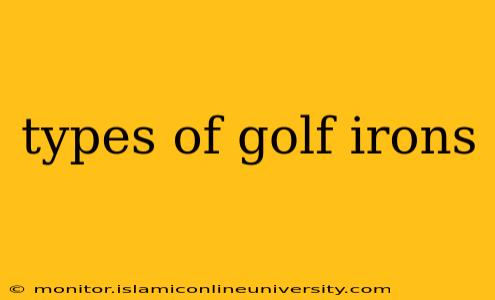Golf irons are fundamental to the game, each designed with specific lofts and characteristics to achieve different shot shapes and distances. Understanding the nuances of each type is crucial for improving your game. This guide will delve into the various types of golf irons, explaining their uses and helping you choose the right clubs for your skill level and playing style.
What are the Different Types of Golf Irons?
Golf irons are generally categorized by their number, ranging from 2-iron to pitching wedge (PW). However, the specific number and inclusion of certain clubs can vary based on the golfer's needs and the set's design. Let's break down the common types:
Long Irons (2-4 Iron):
These clubs are rarely seen in modern golf bags, especially for higher handicap players. Their long shafts and low lofts make them challenging to control for most amateurs. Long irons are designed for maximum distance but require significant skill to hit accurately.
- 2-Iron: The lowest lofted iron, providing the longest distance but demanding precise technique.
- 3-Iron: Slightly more forgiving than the 2-iron, still primarily used for long, accurate shots.
- 4-Iron: Offers a blend of distance and control, becoming more accessible to mid-handicap players.
Mid Irons (5-7 Iron):
These are workhorse clubs for many golfers. They offer a balance between distance and accuracy, making them suitable for a variety of shots from the fairway or tee.
- 5-Iron: A staple in most bags, providing a good blend of distance and control.
- 6-Iron: A versatile club ideal for approach shots to the green.
- 7-Iron: More forgiving than the 5 and 6-iron, often chosen for shots requiring a shorter distance and more accuracy.
Short Irons (8-PW):
These irons are designed for accuracy and control over distance. They are primarily used for approach shots to the green and precise shots around the green.
- 8-Iron: Often used for precise approach shots from mid-range.
- 9-Iron: A higher-lofted club suitable for shorter approach shots and shots requiring a high trajectory.
- Pitching Wedge (PW): The highest-lofted iron in a standard set, providing significant spin and control for shots around the green.
What are the Differences Between Irons?
The key differences between irons lie in their loft, shaft length, and club head design. Loft refers to the angle between the clubface and the shaft. Higher loft means a higher trajectory and shorter distance, while lower loft means a lower trajectory and longer distance. Shaft length also impacts distance; longer shafts generally result in greater distance. Finally, the club head's design influences forgiveness and feel, with larger heads typically more forgiving than smaller ones.
What Type of Golf Iron is Right for Me?
The right type of iron for you depends on your skill level, swing speed, and playing style. Beginners might find a set with more forgiving clubs, such as larger-headed irons and higher lofts, more manageable. More experienced players might prefer a set with a wider range of lofts and smaller heads for greater control and distance.
How Do I Choose the Right Golf Irons?
Consider getting fitted by a professional club fitter. They can analyze your swing and recommend clubs optimized for your specific needs. Don't be afraid to experiment with different clubs and sets to find what feels most comfortable and allows you to consistently hit the best shots.
What are the Best Golf Irons for Beginners?
Many manufacturers design game improvement irons that prioritize forgiveness and ease of use for beginners. These often feature larger club heads and cavity backs to help compensate for less than perfect contact. Look for sets explicitly marketed as "game improvement" or "beginner" irons.
What is the Difference Between Cavity Back and Blade Irons?
- Cavity Back Irons: These irons have a hollowed-out area behind the clubface, raising the center of gravity to increase forgiveness. They are better suited for higher-handicap golfers.
- Blade Irons: These irons are typically smaller and more compact, offering greater feel and control but less forgiveness. They are favored by experienced players with consistent swings.
This comprehensive guide provides a solid foundation for understanding the various types of golf irons. Remember, the best way to choose the right irons is to seek professional advice and experiment to find what works best for your individual game.
